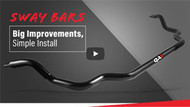What Does A Sway Bar Do?
Sway bars—also known as anti-roll bars—might be the unsung heroes of your suspension. They drastically improve handling and stability, especially during cornering and quick changes in direction. But what are they and how do they do their job?
WHAT IS A SWAY BAR? HOW DOES IT WORK?
Sway bars work in conjunction with your car’s shocks, springs and other suspension components. They improve overall handling by reducing body roll—hence the name anti-roll bars.
WHAT IS BODY ROLL?
Body roll is the feeling you get during cornering. Imagine taking a hard right on a highway exit ramp. As you turn, inertia shifts weight to the left side of the car and loads up the suspension. At the same time, it unloads the suspension on the right side and causes it to lift. That’s why it feels like your vehicle is “rolling” to one side.
HOW TO REDUCE BODY ROLL IN YOUR CAR
A sway bar reduces this effect. In essence, an anti-roll bar is a torsion spring. It resists torsional defection, which adds resistance to the suspension when only one side of the suspension tries to compress.
Let’s go back to our freeway exit. As the car leans to the left, it applies weight to that side of the sway bar and causes the bar to twist. This action transfers load from the outside tires (which are experiencing most of the force) to the inside tires. That leverage provides more grip throughout the turn. The inside tires now take on more of the work and share the load more evenly across all four contact patches.
This process also adds suspension resistance as one side of the suspension is compressing, but not the other. When both sides experience a bump in the road together—like a speed bump—your spring rate is not increased. But when only one side does, spring rate does increase. That means it adds roll resistance without hurting ride quality.
WHEN DO YOU NEED A SWAY BAR?
If you’re going to be chucking your car or truck into corners, you definitely need a sway bar. Even during everyday street driving, sway bars provide stability and help you feel more connected to the road. If your car came equipped with a stock sway bar, upgraded tubular components further improve handling, grip and drivability. Especially during hard corners and at high speeds.
CAN YOU DRIVE WITHOUT A SWAY BAR?
Usually, yes—but be careful, especially if your car was originally equipped with them. Sway bars drastically improve the handling and predictability of your vehicle. If you plan to do spirited driving that involves corners, you definitely want sway bars to minimize body roll and increase grip.
Back in the day, sway bars were often options and instead of standard equipment. This was especially true of pickup trucks and other rigs built for utility—not high-speed corners. Sway bars were more common on vehicles that prioritized handling and stability, like sports cars and pony cars. Today, anti-roll bars are present across all types of vehicles and designed to be a more integral part of the stock suspension.
IS THERE EVER A GOOD TIME TO REMOVE MY SWAY BARS?
If you have a drag racing car, you may opt to run without a front sway bar. This takes weight off the front end and can reduce suspension bind, helping weight transfer to the rear tires during hard launches. However, most drag suspensions greatly benefit from a rear bar. This helps keep the car from overloading one of the rear tires, allowing the other tire to unload, spin and lose traction.
WHAT ARE SWAY BAR ENDLINKS?
End links connect your sway bar to your vehicle. They may attach to your control arm, spindle or chassis depending on your vehicle’s suspension design. They can also be a fixed length or adjustable to suit your application. End links allow your sway bar to pivot while transferring load from side to side, either via bushing flex or spherical joint swivel. This helps prevent suspension bind as the bar twists.
Give us a shout if you have sway bar questions.
Our tech team will happily help you dial in your ride and make sure it behaves the way you want. Give us a call at 952-985-5675.

